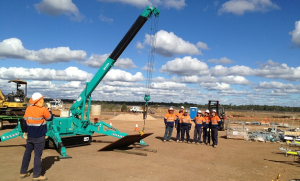
Here at Gallmac Training, we are offering Dogman courses like Dogging Training Brisbane starting every day. We provide the best service at the best price for our Dogging Training Brisbane program. Our trainers are knowledgeable, enthusiastic and eager to provide an enjoyable course for participants, that will result in a nationally recognised Dogging High Risk License.
Gallmac Training provides all necessary resources, materials, equipment and machinery needed to become fully competent at both the written and practical components of the High Risk Dogging Training Brisbane course. We have our own Maeda MC-305C 4 tonne slew crane, that students will become very familiar with over the course. We can also bring our crane to your worksite, provided previous arrangements have been made.
The knowledge and theory covered in this Dogging Training Brisbane course will ensure that students are able to pass the written examination, and have the necessary skills required to be safe in the workplace. Gallmac Training cover the following topics in our Dogging Training Brisbane program:
- Legislation — The laws surrounding High Risk tickets, including how long a statement of attainment is valid for, how often licenses need to be renewed, penalties in relation to failing to maintain your duty of care, and other laws surrounding the Dogging Training Brisbane license.
- Hazards — How to identify and assess a number of potential hazards in a workplace.
- Powerline Information — Voltages of powerlines, safe distances, what are tiger tails and what are their purpose, steps to working within safe distances for powerlines and more.
- Hazard Control Measures — Different hazard controls, when to choose them, when to apply them, and when to check them, as well as how and when to pack up hazard controls.
- Communications — What communications are available for doggers to use, and when each of those communication methods are best used, as well as when to select and when to inspect communication methods and devices.
- Weights — What is your working load limit (WLL) and how to identify what the working load limit is, as well as various methods on determining the weight of a load, and the weights doggers need to know in order to pass their test (i.e. Water, Concrete, Steel)
- Equipment — What equipment is available to doggers, including lifting gear, taglines and P.P.E.
- Synthetic Slings — What different synthetic slings are available, and how to identify their WLL, as well as potential defects that will condemn them from use.
- Flexible Steel Wire Rope (FSWR) — How to identify the working load limit (WLL) of flexible steel wire rope (FSWR), the minimum allowable diameter as well as potential defects that will condemn them from use.
iii. Chains — How to identify the grade of a chain, how to identify the working load limit (WLL) of different grades of chains, what grades of chains are usable for lifting purposes, the minimum grade and diameter permittable for use for lifting purposes, as well as potential defects that will condemn them from use.
- Shackles — The difference between bow shackles and ‘D’ shackles, when to use a bow shackle, when to use a D shackle, how to identify the working load limit of a shackle, as well as potential defects that will condemn them from use.
- Eyebolts — The difference between collared and un-collared eyebolts, when to use collared eye-bolts, when it is acceptable to use un-collared eyebolts, the three things to think about before using eyebolts or lifting lugs.
- Attachments — Different attachments not previously mentioned that can be used for lifting purposes, such as spreader beams, brick cages etc.
vii. Other — Other equipment that dogman need to be familiar with including tagline information (what minimum size to use, what type of rope to use), a whistle and personal protection equipment:
- hard hat
- safety glasses
- hearing protection
- high vis clothing
- gloves
- Trousers
- Rubber soled steel capped boots
viii. Whistle Signals — The whistle signals for slew left, slew right, hook up, hook down, boom up, boom down, extending the telescopic, retracting the telescopic and stopping the crane driver.
- Hand Signals — The hand signals for slew left, slew right, hook up, hook down, boom up, boom down, extending the telescopic, retracting the telescopic and stopping the crane driver.
- Two-way Radios — How to use two-way radios, and how to effectively communicate with a crane operator using two-way radios.
- Verbal communication — Talking, when within hearing range of the crane operator, including active listening, effective body language and asking questions.
xii. Slinging techniques — How to effectively sling a number of different loads, what types of lifting equipment to use for those lifts, the difference between a choke hitch and a basket hitch and the effect this has on your working load limit (WLL).
xiii. Storing Equipment — How to safely store equipment including lifting gear, hazard controls, communication devices, protective gear, and what to consider when storing this equipment.
xiv. Maths — The math component of the Dogging Training Brisbane exam including the formulas for identifying the working load limit of a fibre rope, the working load limit of a flexible steel wire rope, the working load limit of chains, what safety factors, angle factors and reeve factors are, and how to assess the weight of a concrete pipe.
To summarise, Gallmac Training is providing the best, most affordable Dogging Training Brisbane courses in Brisbane. We provide all the necessary resources to provide learners with a safe, easy program that covers all the necessary theory and practical knowledge and skills required to pass both the written and practical assessments for participants to achieve their Dogging Training Brisbane licenses.
To know more about our Dogging Training Brisbane course, please contact us.
